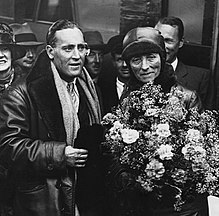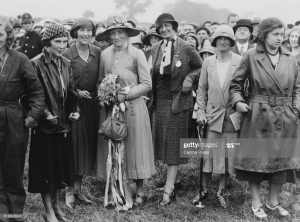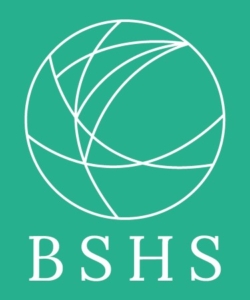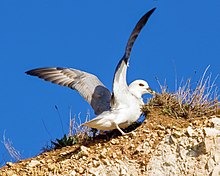Mary du Caurroy Russell, Duchess of Bedford
Ornithologist and Radiographer
c. 1935 in the cockpit of her aeroplane (Image by Fox Photos/Hulton Archive/Getty Images from Country Life 2018)
- BORN 26th September 1865, Stockbridge, Hampshire, England
- DIED 22nd March 1937, Lost in the North Sea near Great Yarmouth, Norfolk, England
- WORKED From 1907-14, she practised ornithology in the islands near western Scotland; She was a radiographer in the model hospital she set up in Woburn, Bedfordshire, England
- HONOURS Dame of the Order of the British Empire; Dame of Grace, Order of St John of Jerusalem; President of the National Cat Association; In 1910, she was one of the first 5 Honorary Lady Members of the British Ornithological Union. That was doubtless a great tribute, but I would feel happier if she had been made a full member.
- MINERVA SCIENTIFICA PROJECT Echoes from Northamptonshire
Entry by Dr Patricia Fara, Emeritus Fellow of Clare College Cambridge and member of the British Society for the History of Science.
Artistic Connections
No record
Music
Title: Bats Moths and Biplanes
Composer: FRANCES M LYNCH
Words by: Frances M Lynch and DORIS MACKINNON
Written: 12th – 14th May 2020
For: Solo Singer with recorded manipulated voices, Bat clicks, Bi-plane engines and natural sounds.
Performed by: electric voice theatre singers – Frances M Lynch, Jenny Miller, Margaret Cameron, David Sheppard, Julian Stocker and Gwion Thomas
First Performed: Online during the Covid-19 Outbreak for the “Echoes from Northamptonshire” programme at Brixworth Music Festival on 15th May 2020
This music was inspired by the Sywell Aerodrome Women’s Meeting of 1931 which you can see on a British Pathé News video from the day itself Queens of the Air and by the wildlife close by at Pitsford Water Nature Reserve and Brixworth Country Park.
The solo singer describes the race and some of the women pilots who took part that day, including aircraft engineer DOROTHY SPICER. The text describing the bats is mainly from zoologist DORIS MACKINNON’s book, The animal’s world which was based on talks she gave on the radio throughout the 1930s, interspersed with information gleaned from discussions with Wildlife Conservationist DEBBIE SAMWELL and Ecologist Mischa Cross.
It was created at Birnam Studios, London as part of electric voice theatre‘s Minerva Scientifica – Connections 2020 project, supported using public funding by the National Lottery through Arts Council England. Frances M Lynch is supported by PRS Foundation’s The Open Fund for Music Creators.
Education
Expensive education for upper-class girls: Cheltenham Ladies’ College and finishing school in Zurich
Occupations
Ornithologist
She studied birds in islands off the west coast of Scotland.
Radiographer
She worked in the X-ray department of the military hospital she set up in Woburn.
Scientific Achievement
As one of the first women to be admitted to the Linnean Society, she was a scientific pioneer.
She carried out substantial research on sea-birds such as fulmars and petrels.
Did You Know?
She was married in India, where her father was Archdeacon of Lahore – and her new husband was the fabulously wealthy Duke of Bedford who owned Woburn Abbey and was a keen zoologist,
A great animal lover, she owned rare Siamese cats and taught her husband’s horses to bow and shake hand & hoof (see picture of book plate below),
Interested in nursing since she was a small child, she set up a model hospital in Woburn, where she undertook many menial tasks herself. During the First World War, it was converted into a military hospital where she worked as a radiographer and as a surgical assistant in the operating theatre,

July 1915, Open Air Ward in her Military Hospital, Woburn Abbey. H Bedford Lemere (image from alamy.com)
An Inspiring Woman
Mary, Duchess of Bedford was an extremely wealthy aristocrat, but she used her money to carry out scientific research and build a hospital that she ran herself.
She was never deterred by age. During her 40s, she regularly went bird-watching on isolated rocky islands, and then in her 50s, she trained as a professional hospital radiographer during the First World War – and when she was 60, she took up flying and achieved some record-breaking long-distance flights.
Nor did she let physical disability hold her back: she became increasingly deaf, but continued to embark on ambitious new projects.

Aviator Mary Russell, Duchess of Bedford (1865 – 1937), circa 1930. (Photo by Keystone/Hulton Archive/Getty Images)

9 Aug 1929
Returns from her record-breaking flight to Karachi (then in India) with her pilot C D Barnard (image from wikimedia commons)

Mary Russell, Duchess of Bedford (1865 – 1937) attends the first All Women’s Flying Meeting at Sywell, Northamptonshire, 19th September 1931. Also present are aviators Pauline Gower, D. Spicer, J. Page, Mrs Victor Bruce and Kathleen, Lady Drogheda. (Photo by Central Press/Hulton Archive/Getty Images)





